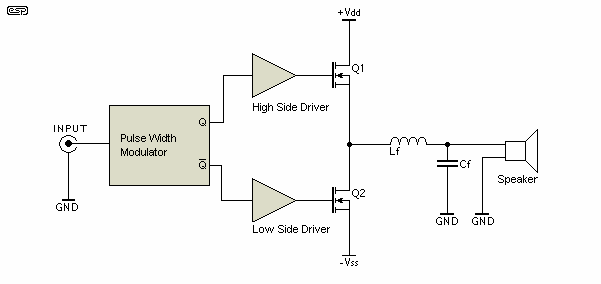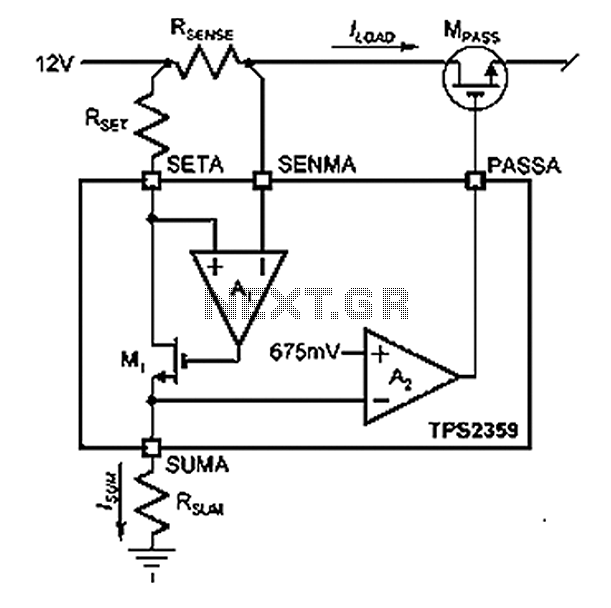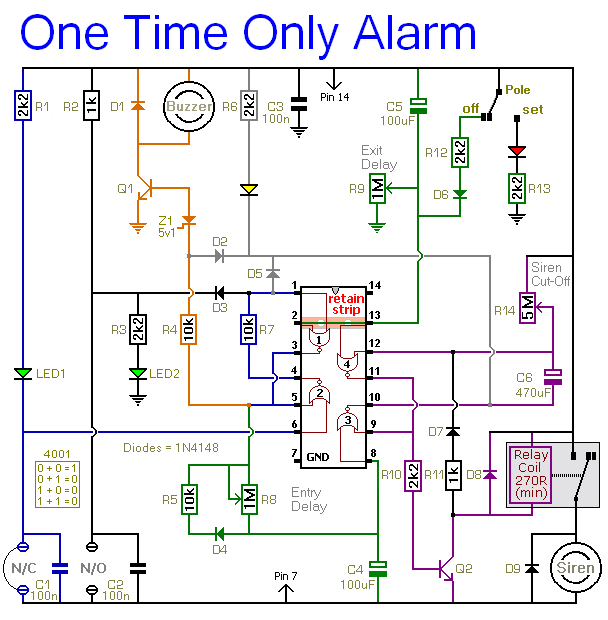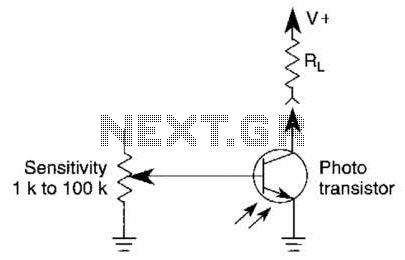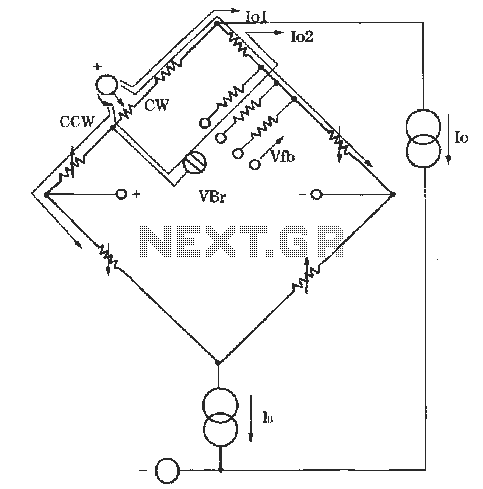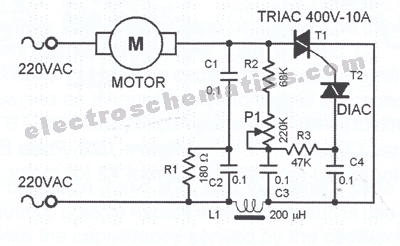
Circuit explanation for the ultrasonic alarm
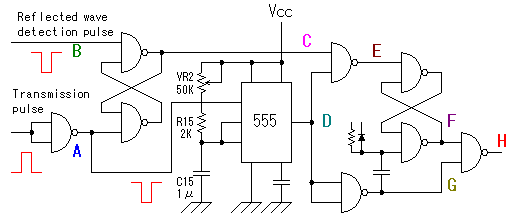
The alarm detector circuit operates differently from the Ultrasonic Alarm (1). In Ultrasonic Alarm (1), an alarm output is triggered by the detection of a reflected wave from an object during the setup time. Conversely, in this circuit, an alarm is output when no reflected wave is detected during the setup time. The presence of the reflected wave during the setup time is detected similarly to Ultrasonic Alarm (1). For details on the timing settings for the 555 timer, refer to the alarm detector of Ultrasonic Alarm (1). The circuit initialization is accomplished with a transmission timing pulse (A), where C is set to "L", D and F to "H", and G to "L", which results in D going to "H". When a reflected wave is detected within the setup time of the 555 timer, C transitions to "H", causing E to shift to "L". Once E goes "L", F also shifts to "L" and remains in that state until the next initialization. G transitions to "H" when D goes "L" due to the timeout of the 555 timer. However, since F is "L", the alarm output H remains at "H", and no alarm signal is generated. If a reflected wave is not detected within the 555 timer's setup time, E remains at "H". When D transitions to "L" after the 555 timer times out, G shifts to "H". Since F is held at "H", H transitions to "L", activating the alarm signal. Even if a reflected wave is detected after the timeout of the 555 timer, D remains at "L", preventing any change in E, which stays at "H", thus maintaining the alarm output. The alarm detection circuit comprises an SR flip-flop (SR-FF) and a 555 timer. The SR-FF for alarm detection, consisting of IC8, must be reset at the rising edge of the timer. The set and reset of the SR-FF are triggered by a low level signal. Therefore, the signal that inverts the timer's output is utilized as the reset signal. The SR-FF should only be reset when the timer operation begins, which is accomplished using a pulse signal generated by a CR-type differentiation circuit. D6 is included for input protection of N2. Upon timeout of the timer, the output of N1 transitions from low to high. At this point, an electric charge is already stored in C25 at the power supply voltage. Without D6, twice the power supply voltage would be applied to the input of N2. The forward voltage of the diode is less than 1V, so the voltage applied to the input of N2 becomes the forward voltage of the diode plus the power supply voltage. In the left figure, a transmission pulse is used to initialize the SR-FF (FF2) for alarm detection. In this circuit, normal initialization does not occur. The issue arises from the time taken for the timer's output to turn ON. It takes time for the timer's output to become active even after the 555 timer is triggered by the transmission pulse. FF2 is immediately reset by the transmission pulse, and signal (4) becomes high due to the rapid operation of the NAND circuit. Consequently, the alarm signal (5) is briefly activated, as indicated by the red line, lasting only a few microseconds. However, this duration is sufficient to trigger the operation of the alarm hold timer. (Refer to the schematic). Therefore, the alarm hold timer is consistently operational. In this circuit, the initialization of FF2 is executed by the falling edge signal (3) of the 555 timer, preventing the alarm signal from being triggered during the initialization process.
The alarm detector circuit utilizes a 555 timer configured in monostable mode to manage timing intervals effectively. The setup time is crucial, as it determines the window during which the presence of a reflected wave is monitored. The circuit's logic is designed such that any detected wave within this window resets the alarm condition, while the absence of a wave triggers the alarm output.
The SR-FF plays a significant role in maintaining the state of the alarm system. It is essential that the reset of the SR-FF occurs precisely at the rising edge of the 555 timer's output to ensure accurate operation. The differentiation circuit produces a pulse that controls the timing of the reset, ensuring that the system responds promptly to changes in the detection status.
Input protection is critical, particularly for N2, where D6 serves to limit voltage spikes that could damage the circuit. The design also incorporates careful consideration of voltage levels, especially during the timer's timeout phase, to prevent excessive voltage from affecting N2's input.
The overall architecture of the alarm detector circuit is tailored to provide reliable operation, with built-in safeguards to prevent false alarms and ensure the system only activates under the correct conditions. The integration of the 555 timer and SR-FF within the circuit allows for flexible timing control and state management, making it suitable for various applications in alarm detection systems.The alarm detector circuit is different from Ultrasonic Alarm (1). In Ultrasonic Alarm (1), an alarm output is presented when there is a reflected wave from the object in the setup time. At the circuit this time, an alarm is output when no reflected wave from the object is detected in the setup time oppositely.
The existence of the reflected wave in the setup time is detected like Ultrasonic Alarm (1) to do this operation. As for the time setting for 555 timer and so on, please refer to Alarm detector of Ultrasonic Alarm (1). The initialization of the circuit is done with transmission timing pulse (A). C to "L", D and F to "H", G to "L" by which D goes to "H". When a reflected wave is detected within the setup time of 555 timer, C goes to "H". With this, the E shifts to "L". When the E goes "L", F shifts "L" and it is held until the next initialization. G shifts to "H" when D goes "L" with the time-out of 555 timer. However, because F is "L", the alarm output H is held on "H" and an alarm signal isn`t output. The initialization of the circuit is done with transmission timing pulse (A). C to "L", D and F to "H", G to "L" by which D goes to "H". When a reflected wave isn`t detected within the setup time of 555 timer, the change of the E doesn`t occur.
It is held on "H". When D goes to "L" by the time-out of 555 timer, G shifts to "H". Because F is held on "H", H shifts to "L" and an alarm signal is output. Even if a reflected wave is detected behind the time-out of 555 timer, because D is held on "L" already, the change of the condition of E doesn`t occur. It is held on "H". So, the alarm output is kept. Alarm detecting circuit is composed of SR-FF (The set and reset type flip-flop circuit) and 555 timer.
The reset of SR-FF for alarm detecting which is composed of IC8 must be reset in the timing of the rising edge of the timer. The set and the reset of SR-FF are done by the L level. Therefore, the signal which reversed the output of the timer is used for the reset signal. Also, SR-FF must be reset only when timer operation is started. So, the pulse signal which is made with CR-type differentiation circuit is used. D6 is put for the input protection of N2. When the timer does in the time-out, the output of N1 shifts to the H level from the L level. At this time, an electric charge with power supply voltage is already stored up in C25. When there is not D6, 2 times of voltage of the power are applied to the input of N2. The forward voltage of the diode is less than 1V. So, the voltage to apply input of N2 becomes the forward voltage of diode + power supply voltage. In the left figure, a transmission pulse is used for the initialization of SR-FF(FF2) for the alarm detection.
In case of this circuit, normally initialization operation isn`t done. The problem is the time that the output of the timer becomes ON. It takes time the output of the timer becomes ON even if it starts 555 timers by the transmission pulse. FF2 is immediately reset by the transmission pulse and signal (4) becomes H level because of the high-speed operation of the NAND circuit.
As a result, alarm signal (5) occurs in short time to have drawn by the red line. This signal is several microseconds. However, it is enough time to make do the operation of the alarm hold timer. ( Refer to the schematic ) Therefore, the alarm hold timer has always operated At the circuit this time, the initialization of FF2 is done by the falling edge signal (3) of 555 timer. So, it doesn`t let out an alarm signal by the initialization operation. 🔗 External reference
The alarm detector circuit utilizes a 555 timer configured in monostable mode to manage timing intervals effectively. The setup time is crucial, as it determines the window during which the presence of a reflected wave is monitored. The circuit's logic is designed such that any detected wave within this window resets the alarm condition, while the absence of a wave triggers the alarm output.
The SR-FF plays a significant role in maintaining the state of the alarm system. It is essential that the reset of the SR-FF occurs precisely at the rising edge of the 555 timer's output to ensure accurate operation. The differentiation circuit produces a pulse that controls the timing of the reset, ensuring that the system responds promptly to changes in the detection status.
Input protection is critical, particularly for N2, where D6 serves to limit voltage spikes that could damage the circuit. The design also incorporates careful consideration of voltage levels, especially during the timer's timeout phase, to prevent excessive voltage from affecting N2's input.
The overall architecture of the alarm detector circuit is tailored to provide reliable operation, with built-in safeguards to prevent false alarms and ensure the system only activates under the correct conditions. The integration of the 555 timer and SR-FF within the circuit allows for flexible timing control and state management, making it suitable for various applications in alarm detection systems.The alarm detector circuit is different from Ultrasonic Alarm (1). In Ultrasonic Alarm (1), an alarm output is presented when there is a reflected wave from the object in the setup time. At the circuit this time, an alarm is output when no reflected wave from the object is detected in the setup time oppositely.
The existence of the reflected wave in the setup time is detected like Ultrasonic Alarm (1) to do this operation. As for the time setting for 555 timer and so on, please refer to Alarm detector of Ultrasonic Alarm (1). The initialization of the circuit is done with transmission timing pulse (A). C to "L", D and F to "H", G to "L" by which D goes to "H". When a reflected wave is detected within the setup time of 555 timer, C goes to "H". With this, the E shifts to "L". When the E goes "L", F shifts "L" and it is held until the next initialization. G shifts to "H" when D goes "L" with the time-out of 555 timer. However, because F is "L", the alarm output H is held on "H" and an alarm signal isn`t output. The initialization of the circuit is done with transmission timing pulse (A). C to "L", D and F to "H", G to "L" by which D goes to "H". When a reflected wave isn`t detected within the setup time of 555 timer, the change of the E doesn`t occur.
It is held on "H". When D goes to "L" by the time-out of 555 timer, G shifts to "H". Because F is held on "H", H shifts to "L" and an alarm signal is output. Even if a reflected wave is detected behind the time-out of 555 timer, because D is held on "L" already, the change of the condition of E doesn`t occur. It is held on "H". So, the alarm output is kept. Alarm detecting circuit is composed of SR-FF (The set and reset type flip-flop circuit) and 555 timer.
The reset of SR-FF for alarm detecting which is composed of IC8 must be reset in the timing of the rising edge of the timer. The set and the reset of SR-FF are done by the L level. Therefore, the signal which reversed the output of the timer is used for the reset signal. Also, SR-FF must be reset only when timer operation is started. So, the pulse signal which is made with CR-type differentiation circuit is used. D6 is put for the input protection of N2. When the timer does in the time-out, the output of N1 shifts to the H level from the L level. At this time, an electric charge with power supply voltage is already stored up in C25. When there is not D6, 2 times of voltage of the power are applied to the input of N2. The forward voltage of the diode is less than 1V. So, the voltage to apply input of N2 becomes the forward voltage of diode + power supply voltage. In the left figure, a transmission pulse is used for the initialization of SR-FF(FF2) for the alarm detection.
In case of this circuit, normally initialization operation isn`t done. The problem is the time that the output of the timer becomes ON. It takes time the output of the timer becomes ON even if it starts 555 timers by the transmission pulse. FF2 is immediately reset by the transmission pulse and signal (4) becomes H level because of the high-speed operation of the NAND circuit.
As a result, alarm signal (5) occurs in short time to have drawn by the red line. This signal is several microseconds. However, it is enough time to make do the operation of the alarm hold timer. ( Refer to the schematic ) Therefore, the alarm hold timer has always operated At the circuit this time, the initialization of FF2 is done by the falling edge signal (3) of 555 timer. So, it doesn`t let out an alarm signal by the initialization operation. 🔗 External reference
Warning: include(partials/cookie-banner.php): Failed to open stream: Permission denied in /var/www/html/nextgr/view-circuit.php on line 713
Warning: include(): Failed opening 'partials/cookie-banner.php' for inclusion (include_path='.:/usr/share/php') in /var/www/html/nextgr/view-circuit.php on line 713
